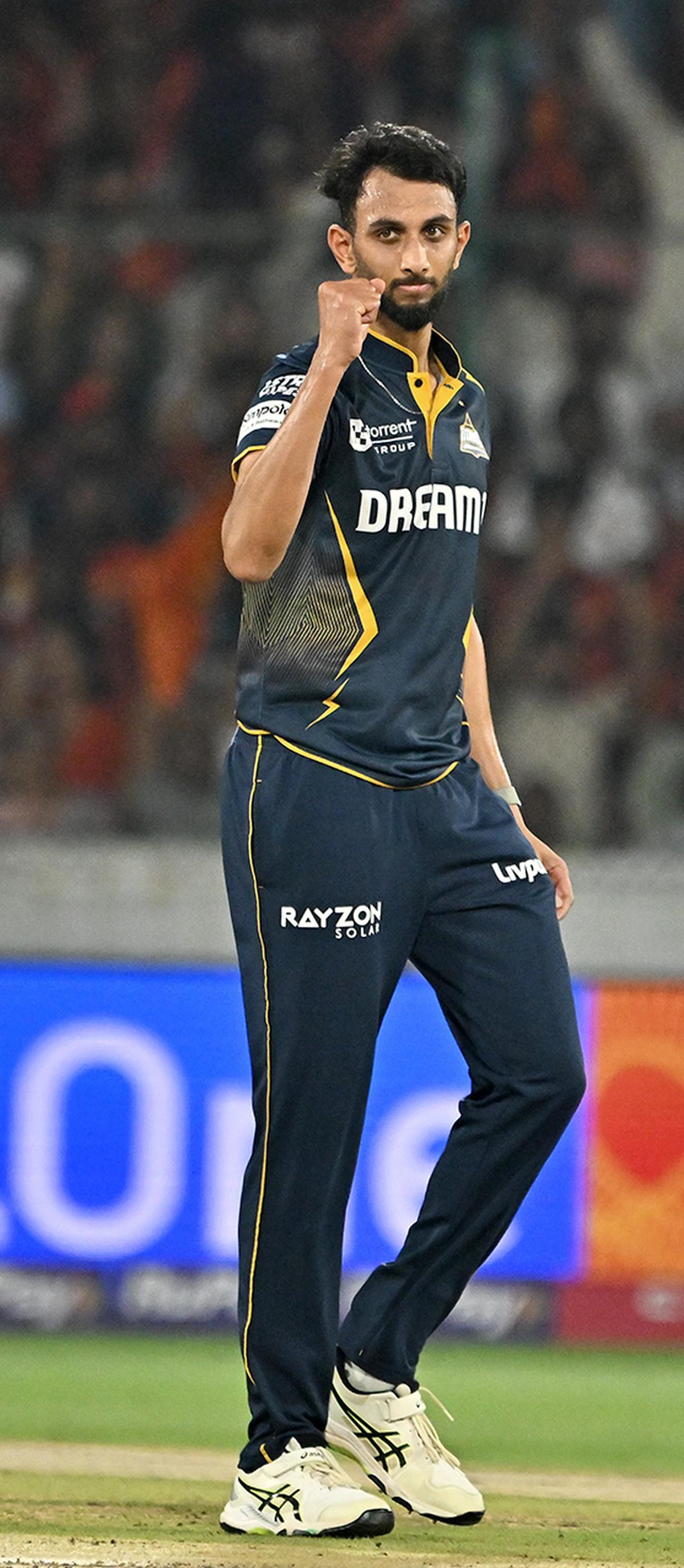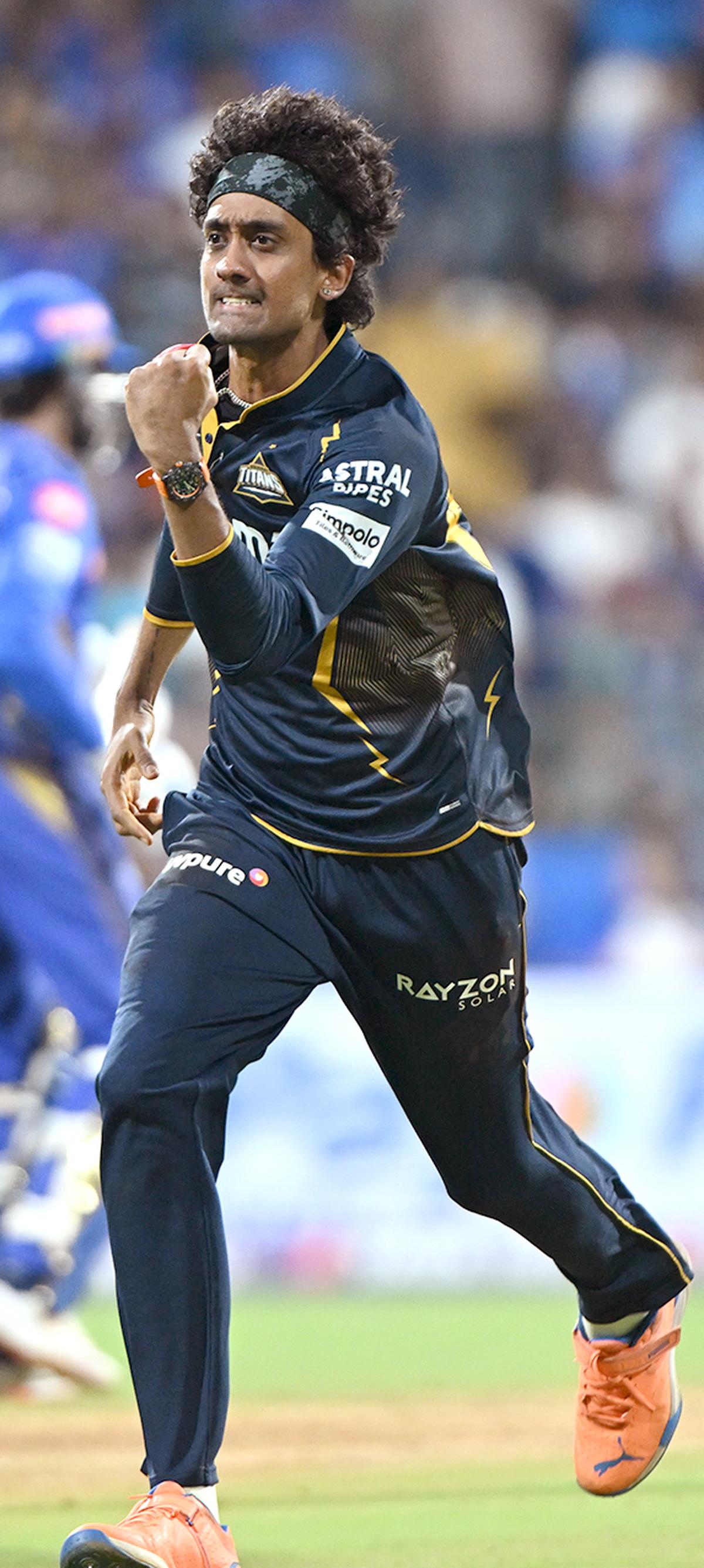In an era long gone by, Afghanistan’s left-arm wrist-spinner Noor Ahmad would have walked away with the Purple Cap for being the highest wicket-taker at the conclusion of the league phase of the Indian Premier League. Noor might still do so – he leads this year’s race with 24 wickets despite his team, Chennai Super Kings, propping up the table for the first time in the tournament’s history – but if Prasidh Krishna continues his red-hot form, he will get at least one opportunity to build on his tally of 23 wickets when Gujarat Titans take on Mumbai Indians in Friday’s Eliminator in Mullanpur.
The IPL is essentially by the Indians and for the Indians – yes, yes, it does include top players from most of the rest of the world – and never has that been more apparent than in Season 18, when Indian stars established and emerging have taken the tournament by storm. There are notable exceptions, as there are bound to be – Noor, for one, alongside Trent Boult and Josh Hazlewood among the bowlers — and Mitch Marsh, Jos Buttler and Nicholas Pooran when it comes to the batters. But homegrown talent has held massive sway, reiterating that the future of Indian T20 cricket, at the very least, is in safe, competent, young hands.
The phenoms
No one is younger, of course, than the kid from Samastipur in Bihar who very few knew about two months back. Vaibhav Suryavanshi had made his Ranji Trophy debut at 13 and already scored a century for India Under-19 against Australia Under-19 in a four-day ‘Test’ last year, but it was the grand stage that the IPL
is that propelled him into international limelight. At 14 years and 32 days, he became the youngest batter to score a century in senior T20 cricket; his 35-ball ton for Rajasthan Royals against Gujarat Titans is the fastest by an Indian. He might have begun the tournament as a starry-eyed teenager who must have gobbled at a price tag of ₹1.1 crore, but he ends it a marked lad, someone of whom great things are already being expected and who is, unfairly, drawing comparison with India’s most famous teen phenom, a certain
Sachin Tendulkar.
Vaibhav Suryavanshi
| Photo Credit:
R.V. MOORTHY
Suryavanshi and his India Under-19 captain Ayush Mhatre, who sparkled after belatedly being blooded by
CSK, are already spreading waves of awe and fear within the junior fraternity – outside it, too, but it’s the Under-19 opponents who are most likely to feel the brunt of their fury in the immediate future. The Indian colts travel to England next month for five 50-over games and two four-day fixtures. Perhaps echoing the sentiments of the rest of the cricket world, former New Zealand captain and CSK coach Stephen Fleming admitted he worried ‘a little bit about the Under-19 oppositions that will come up against two pretty handy openers when the World Cup comes around.’ “It’s amazing how much talent they have, how composed they are,” Fleming, who himself was only 19 when he first played for his country, crowed.
The swashbuckling 14-year-old left-hander and the more orthodox 17-year-old right-hander from Mumbai headlined a rash of extraordinary but lesser-known talent that took the league stage of the tournament by storm with the bat. Priyansh Arya might appear of a different vintage from the two teenagers – he is only 24 but how do you compete with 14 and 17 for eyeballs? – but he has had a memorable first season. Bought by Punjab Kings for ₹3.8 crore, he has more than justified the price tag and the expectations with 424 runs at the whopping strike-rate of 183.6, showing that marrying consistency with naked aggression comes reasonably easy to him. He announced himself early in the tournament with a hundred and hasn’t disappointed since; like his equally fearsome opening partner Prabhsimran Singh (499 runs), he will have at least two more chances to add to that tally, given that the Kings have made it to the playoffs (as the top-ranked team, no less) for the first time since 2014.
Racking it up
Of the 10 batters who racked up more than 500 runs in the league phase are seven Indians, none of whom can be called a newcomer by any stretch of imagination. B. Sai Sudharsan, who leads the race for the Orange Cap with 679 runs, 30 more than Gujarat Titans opening partner and new India Test skipper Shubman Gill, is perhaps the ‘newest comer’ of this bunch. The other five – Suryakumar Yadav, Virat Kohli (who has topped 600 runs for a third season on the bounce), Yashasvi Jaiswal, K.L. Rahul and Shreyas Iyer – have all been there and done that. Indians have accounted for seven of the nine hundreds this far (Mitchell Marsh and Heinrich Klaasen are the exceptions). Outside of this ‘500 club’ and those mentioned previously, Abhishek
Sharma has continued on his merry way, Ishan Kishan has sets hearts aflutter in Hyderabad and who can forget Jitesh Sharma’s extraordinary onslaught on Tuesday night that muscled Royal Challengers Bengaluru past Rishabh Pant’s Lucknow Super Giants and to the second place at the end of the league skirmishes?
Openers Sai Sudharsan and Gill, alongside former England skipper Buttler who will miss the playoffs due to international commitments, accounted for the bulk of Gujarat’s runs this season. The left-handed Sai Sudharsan and his equally classy right-hander mirror-image captain have together put on 909 runs as an opening pair, including an unseparated 205 against Delhi Capitals in a most surreal run-chase. A little while back, in the immediacy of Rohit Sharma and Kohli’s retirement from T20Is, it seemed as if Gill and Jaiswal would be the long-term 20-over openers for the country, an opinion that gathered pace when they put on 67 and 156 (unbroken) in successive outings in Zimbabwe last July. Then, Abhishek and Sanju Samson threatened to queer the pitch with Gill and Jaiswal away on Test duty. Now, a new pair is in town, making it impossible to overlook its exploits. India seem spoiled for batting choices. See how Tilak Varma, who made successive centuries whilst batting at No. 3 in South Africa last December, hasn’t even figured in this piece till now?
These are the obvious success stories but there are others who don’t have the same inflated numbers and yet have made a grand impact – men like Dhruv Jurel, Ayush Badoni, Ashutosh Sharma, Shashank Singh, even Vipraj Nigam and Riyan Parag, who smashed six sixes in as many deliveries (spread over two overs) in a losing cause. Several of them have been around for a while and while Jurel and Parag are already internationals, the rest know that if they aspire to don the India Blue, they still have plenty of work ahead of them. What a luxury for T20 captain Suryakumar, head coach Gautam Gambhir and selection panel chief
Ajit Agarkar to be able to dip into an overflowing pool of riches that is clearly the envy of the rest of the world.
If the batters have hogged the space till now, put it down to cricket being a batter’s game. But India’s bowling group hasn’t been too shabby either. Of the 17 bowlers who had at least 15 wickets after the 70-match first phase, only five are non-Indians. There is a nice blend of the proven and the promising, of pacers and spinners, of left-armers and right-armers, of the orthodox and the unconventional among the dozen Indians in that grouping. There is Jasprit Bumrah – of course there will be Jasprit Bumrah, even if he missed the first four matches – and there are the usual suspects, Arshdeep Singh and Varun Chakaravarthy and
Harshal Patel and Kuldeep Yadav but most heartening must be the form shown by Prasidh and the spunk revealed by R. Sai Kishore, the curly-mopped other left-handed ‘Sai’ from Chennai who led the State side in the Ranji Trophy last season.

Prasidh Krishna
| Photo Credit:
K.V.S. GIRI
Prasidh has been terrific to watch all season, making use of his bounce and his recent burst of confidence and feel-good to produce wicket-taking deliveries with exceptional consistency. He is among the tallest fast bowlers in India currently and is beginning to make excellent use of that feature, hitting the lengths that make it impossible for batters to get him away. His wickets have come at one every 14.34 deliveries but that’s not only because batters have tried to go after him. He hasn’t ‘bought’ his wickets, if you like, as an economy of 7.90 runs an over will testify. Having impressed on his Test comeback after 12 months in Sydney in January, it will be a huge surprise if he doesn’t line up alongside Bumrah at Headingley in three weeks’ time when the first Test gets underway. This isn’t a case of the IPL fast-tracking a Test career, it is just that Prasidh has reiterated that even in 20-over cricket, traditional values will still hold a bowler in grand stead.

R. Sai Kishore
| Photo Credit:
EMMANUAL YOGINI
Sai Kishore tapered off a little after a glorious start but like Prasidh, he is also a smart and orthodox cookie but hardly unidimensional. He has been on the selectors’ radar for a while and with Ravindra Jadeja in the autumn of his career, should fancy his chances across formats though the re-emergence of Krunal Pandya, who has 15 wickets to Sai Kishore’s 17 but is handier with the bat, might dictate otherwise, at least in the 20-over game. To many, the IPL is an opportunity to make a very good livelihood out of cricket while reconciling to the knowledge that they might not seriously tickle the national selectors’ mind space. To others like
Sai Kishore, the IPL is only a springboard to greater heights, stemming from a realistic assessment of one’s abilities and aspirations.
As the tournament hurtles towards its business end, there will be grandstand performances, for sure, but it will take something special to overshadow the league riches. Now, that’s something to look forward to, right?
Published – May 29, 2025 11:56 pm IST
